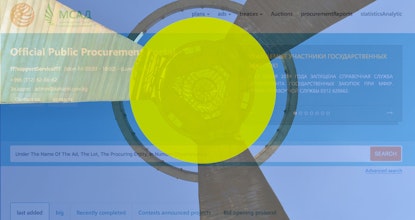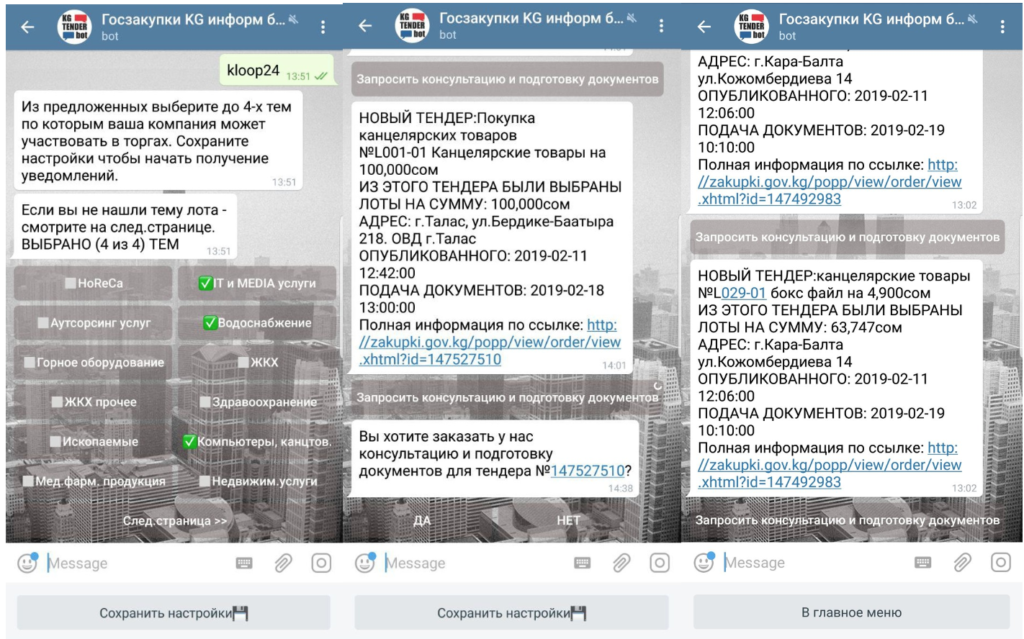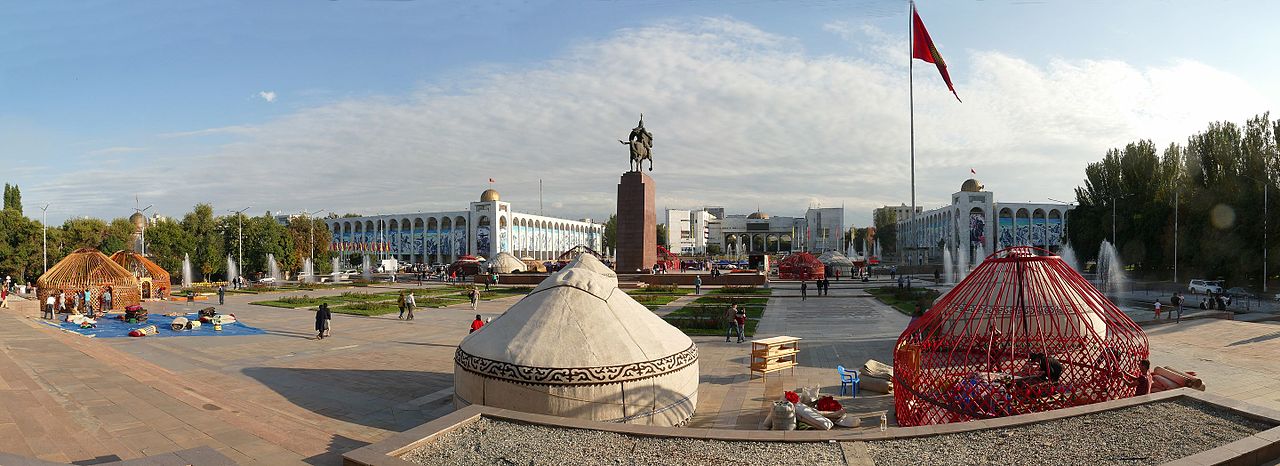Kyrgyz Republic: How open contracting can support small business

This is part of a new series of country data reviews looking at progress in publishing and using open contracting data by our partners. We will focus on:
i) the goal of using the data;
ii) the progress made so far;
iii) what’s working and what the challenges are; and
iv) next steps to get to mass adoption and impact.
Our first blog looks at the Kyrgyz Republic’s efforts to implement the Open Contracting Data Standard to create a fairer, level playing field for smaller companies to win government contracts.
Read on to find out how they developed a publicly available contracting platform, an internal business intelligence tool for public finance monitors; and a simplified e-catalogue procedure for low-value procurement. Hundreds of businesses have signed up for a mobile app advertising upcoming tenders too.
1. Setting the goal, making the commitment, securing support
The Kyrgyz Republic, like many other countries in economic transition, is keen to shift its economy away from state-controlled behemoths to a thriving small business sector. Public procurement is the frontline of that change, but small and medium enterprises (SMEs) face multiple obstacles that prevent them from competing in the market, such as complex procedures, a lack of experience and weaknesses in the regulatory framework that distort competition.
The Kyrgyz Republic has been working to reform the sector, due to concerns that low transparency in public procurement was not only limiting the participation of potential suppliers, but also driving up public procurement expenditure and supporting cronyism.
In its 2018 Open Government Partnership (OGP) Action Plan, the Kyrgyz government committed to change the laws so that procuring entities would be required to publish more information about their contracts, including the full text of contracts and information on contract implementation. The Ministry of Finance, leading on the commitment, also pledged to start publishing procurement information as open data, which would allow analytics tools to be developed for public finance monitoring, and committed to building relationships with civil society actors who might have an interest in using the data.

2. The progress so far
SME participation
With the support of the European Bank for Reconstruction and Development (EBRD), a diagnostic exercise looked into challenges facing SMEs, using existing data from the government’s main electronic procurement portal. No clear data had been collected about the number of SMEs taking part in public procurement although participation was clearly low in general. This was despite a steady increase in the number of companies signing up to the system in recent years. Of the 13,541 companies registered (of any size) in the system in 2016, only 2803 bid on competitive tenders, according to the diagnostic exercise; and just a third of those bidders (784) won a tender.
Between 2014 and 2017, there was a worrying uptick in direct awards. These are permitted in the Kyrgyz Republic for any procurement under 1 million KGS (around 12,700 EUR) but it appears that authorities were using them to avoid competition. In December 2014, the average tender was worth over 16 million KGS (around 207,000 EUR) but by March 2016, it seems tenders rarely reached 1 million KGS. It seems likely that procurers were reducing the value of contracts to allow them to make direct awards, which involve less paperwork but less scrutiny, making the process unfair and the best value difficult to obtain. An alternative method for lower value tenders, called the “simplified method” had numerous bottlenecks, document requirements and other obstacles that discouraged smaller companies from participating. In practice, there was hardly any difference between the simplified method and the single stage tendering process used for higher value procurement processes.
Total value of all tenders vs. average tender value in KGS: For tenders under 1 million KGS (and for larger state companies under 3 million KGS), procuring entities have the choice of using the direct method or simplified procedure. Where they have this choice, they may prefer to use the direct method which is less time-consuming and bureaucratic, but also less transparent. Before March 2016, the average value of tenders was well above the 3 million KGS threshold. However, since March 2016, it seems they rarely attained the 1 million KGS threshold.
SME needs and challenges
To complement this analysis, the Public Procurement Department (PDD) surveyed 597 businesses, some 91% of which were SMEs and some 90% of which were registered on the national public procurement portal. The majority of respondents took part in procurement on a regular basis, both as competitive bidding and direct contracting. The top factors that businesspeople said would encourage them to take part in procurement more were:
- if the evaluation of bids were transparent;
- if the number of documents were reduced for participating in the bid process;
- if procedures were simplified;
- if documents and payments were electronic;
- if qualification requirements were simplified.
A new e-catalogue procedure
Based on these insights from the statistical analysis and business survey, a team at the PDD decided to create an ‘online shopping’ e-catalogue procedure to radically simplify the whole process. Set to be introduced in late September this year, the new procedure provides both purchasers and bidders with a less complex method for awarding low-value tenders, while remaining a competitive alternative to the direct award procedure.
Data-driven tools
As another part of their trust-building, the team aimed to significantly improve the procurement information available to businesses and citizens by publishing accessible dashboards and analyses using the Open Contracting Data Standard (OCDS). The government did this by converting data from their existing electronic procurement system and publishing OCDS data on their official procurement platform Zakupki.gov.kg.
We will dive deeper into the quality of the Kyrgyz OCDS implementation in the next section.
A business intelligence tool has also been developed for internal use by the Ministry of Finance’s monitoring unit and the Chamber of Accounts, the agency responsible for audits.
Sample analytics from the Kyrgyz open contracting business intelligence tool
The data is also being reused by a mobile app, Tenderbot, a commercial service that alerts suppliers to new tenders and answers basic questions about upcoming contracts. We’ll discuss these data-driven tools in more detail in section 4.
3. OCDS: what’s working and what’s been challenging
To make its procurement information more open and user-friendly, the Kyrgyz team produced middleware that could extract OCDS data from their existing electronic procurement systems. This is the “pull and convert” approach that we outline in our guide on getting your data together. The OCDS data is extracted at regular intervals and placed onto the Zakupki.gov.kg web portal and its analytics module.
The tooling has been automated to extract and update the OCDS data at 60-minute intervals.
Data coverage
The OCDS data covers the tender, award and contract stages of the contracting process, since the Kyrgyz data source does not yet provide full information about planning and contract implementation stages.
The Kyrgyz OCDS data follows good practice by including additional information using extensions, which give publishers a structured way to share extra data beyond the core OCDS building blocks. In this case, the team used the bid statistics and details extension, core extensions for lots, plus the additional contact points community extension. The bids extension allows the Kyrgyz government to disclose bidding information (including the status, date and organizations responsible) and connect awards to bids. Using the lots extension, they can publish structured information about tenders that are broken down into lots (parts that can be bid upon, and awarded separately). This could be particularly helpful for e-catalogues. Finally, the additional contact points extension means multiple contact points can be provided for organizations, which is helpful when the organization does not have a primary contact point.
Remaining data challenges
The middleware has an application programming interface (API) to publish OCDS data, but sadly, it isn’t open for general use. This affected our ability to assess the quality of the data. To use the Kyrgyz data currently, citizens and advocacy groups would need to rely on manipulating and downloading JSON files, which can be difficult to collate and query. An API would be much easier to navigate and could provide a common interface from which innovators could produce new ways to interact with the data. One key recommendation to the government is to change the access to the API to make it fully online and accessible to all. This should not be technically challenging and, of course, our helpdesk would be happy to help.
There are a few remaining issues with data quality. Some of the numerical values in the data are being output as text. Thus, each tool that makes use of the data must convert the text to an appropriate number format before the data can be used in important calculations. Resolving these issues requires an update to the e-procurement system, which would involve a subsequent round of OCDS implementation to improve historical data and to publish new features.
We also identified some structural barriers to publishing OCDS data in the Kyrgyz Republic. For example, the source data does not provide information on whether winners or bidders are SMEs, which makes it more difficult to track the impact of policy and process changes in real time. Kyrgyz law also prohibits the publication of document contents, so links to source procurement documents are not published in the OCDS. This makes a detailed examination of procurement more difficult. If Kyrgyz is serious about improving outcomes for SMEs, then these fixes will be important steps.
4. Using open contracting data for audits and improving market access
The OCDS data is already being used in several contexts. An internal government business intelligence tool has been developed to provide a variety of analytical services for the monitoring unit at the Ministry of Finance.
The Kyrgyz Chamber of Accounts is integrating insights from the business intelligence tool into their auditing processes (both to identify the need for an audit and during the audit itself). They have found the tool particularly valuable for improving efficiency, according to a representative of the Chamber, Dinara Duishenkul. It significantly reduces the time required to collect and analyze data for the Chamber’s annual procurement and budget reports, and up to 60% of audit planning can now be conducted without site visits. Other once time-consuming processes have been automated, such as obtaining procurement plans, and tracking announcements. The tool is also useful for comparing prices for the same item across the country. The Chamber of Accounts is developing further specialized auditing tools using the OCDS and training auditors to improve their data literacy.
There has also been an enthusiastic uptake from the private sector of Tenderbot: a paid service that uses public data from the government procurement database. Run through the secure mobile messaging client Telegram, the app allows users to subscribe to be notified of relevant procurement opportunities. Tenderbot’s key target customers are SMEs, according to one of the tool’s managers, Ulugbek Akishev, who said he sees great potential among these companies because of their interest in market fairness and improving the procurement system. Around 900 people currently use the tool (of which, 100 are paid subscribers). Feedback from users informs upgrades to the system (such as regional subscriptions and tender category filters). The tool was developed as a side project by journalists from the media organization Kloop, who have long used procurement data in their reporting.
Akishev, a news editor at Kloop, says the government’s new procurement system is much easier to work with, as the data is structured and transparency is much higher. In the past, for example, it appeared certain tenders had been intentionally “hidden” in the procurement database by misspelling details such as supplier names with a mix of Cyrillic and Latin letters. While procurement processes are still very vulnerable to manipulation, says Akishek, the risk is now concentrated within the practices of the procuring entity, not the system administrator. To tackle that challenge, he notes, will take time and effective oversight from controlling bodies like the Chamber of Accounts and civic actors. The developers plan to publish a simplified dataset for NGOs in the near future.

5. Looking ahead to 2020
The government has recently adopted changes to the procurement law to introduce a new procedure, the ‘online shopping’ e-catalogue. It will simplify small-value procurement processes and increase efficiency, and is expected to become active later in September 2019. OCDS data will be used to measure whether the new procedure helps businesses to secure contracts through competitive opportunities.
Further improvements to the existing systems (API, middleware, web portal) would enhance the quality of the OCDS data available. Pressure from data users, such as Tenderbot customers and the Kyrgyz Chamber of Accounts, could help to push through these changes, such as improving access to the data by opening up the API to general use and patching some of the quality issues we noted in section 3.
The Kyrgyz Republic aims to create a public business intelligence tool using the OCDS data to complement the one that they are using in private. In the meantime, they will create static reports of key performance indicators. The government also plans more stakeholder engagement activities, with business as well as academia, to build awareness and support for the reform and encourage more use of data and monitoring. The Ministry of Health is expected to develop a stock management system that will link to the e-procurement system in the near future. We will be keen to continue our engagement in the Kyrgyz Republic to see whether these reforms lead to the intended benefits.
How we and others helped: The Kyrgyz Republic’s open contracting efforts are supported by the European Bank of Reconstruction and Development (EBRD) technical cooperation project and the OCDS helpdesk. The OCDS helpdesk has been assisting the Kyrgyz Republic towards their goals by advising them in producing procurement data in the OCDS format. We’ve helped them through the stages of the Open Contracting journey by: getting directly involved in mapping activities; evaluating the quality and validity of Kyrgyz’s OCDS data; giving the government feedback; and ensuring the development was on track. The EBRD also helped the Kyrgyz team to better understand the challenges facing private sector participation in electronic public bidding.

Photo credit: ITO (CC BY 2.0)